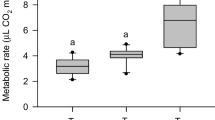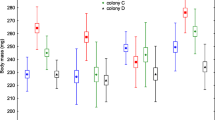Abstract
The CO2 production of individual larvae of Apis mellifera carnica, which were incubated within their cells at a natural air humidity of 60–80%, was determined by an open-flow gas analyzer in relation to larval age and ambient temperature. In larvae incubated at 34 °C the amount of CO2 produced appeared to fall only moderately from 3.89±1.57 µl mg−1 h−1 in 0.5-day-old larvae to 2.98±0.57 µl mg−1 h−1 in 3.5-day-old larvae. The decline was steeper up to an age of 5.5 days (0.95±1.15 µl mg−1 h−1). Our measurements show that the respiration and energy turnover of larvae younger than about 80 h is considerably lower (up to 35%) than expected from extrapolations of data determined in older larvae. The temperature dependency of CO2 production was determined in 3.5-day-old larvae, which were incubated at temperatures varying from 18 to 38 °C in steps of 4 °C. The larvae generated 0.48±0.03 µl mg−1 h−1 CO2 at 18 °C, and 3.97±0.50 µl mg−1 h−1 CO2 at 38 °C. The temperature-dependent respiration rate was fitted to a logistic curve. We found that the inflection point of this curve (32.5 °C) is below the normal brood nest temperature (33–36 °C). The average Q10 was 3.13, which is higher than in freshly emerged resting honeybees but similar to adult bees. This strong temperature dependency enables the bees to speed up brood development by achieving high temperatures. On the other hand, the results suggest that the strong temperature dependency forces the bees to maintain thermal homeostasis of the brood nest to avoid delayed brood development during periods of low temperature.





Similar content being viewed by others
Abbreviations
- m :
-
body mass
- R :
-
rate of development or respiration
- T I :
-
inflexion point of a logistic (sigmoid) curve
- T L :
-
lethal temperature
- T O :
-
temperature of optimum (maximum) development
References
Allen MD (1959) Respiration rates of larvae of drone and worker honey bees, Apis mellifera. J Econ Entomol 52:399–402
Bodenheimer FS (1937) Studies in animal populations. II. Seasonal population-trends of the honey-bee. Q Rev Biol 12:406–425
Büdel A (1955) Schwankungen der Lufttemperatur in der Wabengasse eines brütenden Bienenvolkes. Z Bienenforsch 3:88–92
Bujok B, Kleinhenz M, Fuchs S, Tautz J (2002) Hot spots in the bee hive. Naturwissenschaften 89:299–301
Esch H (1960) Über die Körpertemperaturen und den Wärmehaushalt von Apis mellifica. Z Vergl Physiol 43:305–335
Fahrenholz L, Lamprecht I, Schricker B (1989) Thermal investigations of a honey bee colony: thermoregulation of the hive during summer and winter and heat production of members of different bee castes. J Comp Physiol B 159:551–560
Greenlee KJ, Harrison JF (2004) Development of respiratory function in the American locust Schistocerca americana I. Across-instar effects. J Exp Biol 207:497–508
Harbo JR, Bolten AB (1981) Development times of male and female eggs of the honey bee. Ann Entomol Soc Am 74:504–506
Haydak MH (1970) Honey bee nutrition. Annu Rev Entomol 15:143–156
Heinrich B (1981) The mechanisms and energetics of honeybee swarm temperature regulation. J Exp Biol 91:25–55
Heinrich B (1993) The hot-blooded insects, strategies and mechanisms of thermoregulation. Springer, Berlin Heidelberg New York
Hepburn HR (1986) Honeybees and wax: an experimental natural history. Springer, Berlin New York
Hepburn HR, Armstrong E, Kurstjens SP (1983) The ductility of native beeswax is optimally related to honeybee colony temperature. S Afr J Sci 79:416–417
Hepburn HR, Kurstjens SP (1988) The combs of honeybees as composite materials. Apidologie 19:25–36
Hess WR (1926) Die Temperaturregulierung im Bienenvolk. Z Vergl Physiol 4:465–487
Himmer A (1932) Die Temperaturverhältnisse bei den sozialen Hymenopteren. Biol Rev 7:224–253
Kleinhenz M, Bujok B, Fuchs S, Tautz J (2003) Hot bees in empty broodnest cells: heating from within. J Exp Biol 206:4217–4231
Kronenberg F, Heller HC (1982) Colonial thermoregulation in honey bees (Apis mellifera). J Comp Physiol B 148:65–76
Leonhard B, Crailsheim K (1999) Temperature dependency of the oxygen consumption by a thorax homogenate of worker honeybees (Hymenoptera: Apidae). Entomol Gen 24:31–36
Lindauer M (1954) Temperaturregulierung und Wasserhaushalt im Bienenstaat. Z Vergl Physiol 36:391–432
Mackasmiel LAM, Fell RD (2000) Respiration rates in eggs of the honey bee, Apis mellifera. J Apic Res 39:125–135
Melampy RM, Willis ER (1939) Respiratory metabolism during larval and pupal development of the female honeybee (Apis mellifica L.). Physiol Zool 12:302–311
Moritz RFA, Southwick EE (1992) Bees as superorganisms. Springer, Berlin Heidelberg New York
Ratte HT (1984) Temperature and insect development. In: Hoffmann KH (ed) Environmental physiology and biochemistry of insects. Springer, Berlin Heidelberg New York, pp 33–66
Ritter W (1982) Experimenteller Beitrag zur Thermoregulation des Bienenvolks (Apis mellifera L.). Apidologie 13:169–195
Ritter W, Koeniger N (1977) Influence of the brood on the thermoregulation of honeybee colonies. Proceedings of the 8th Congress of the IUSSI, Wageningen, pp 283–284
Rothe U, Nachtigall W (1989) Flight of the honey bee. IV. Respiratory quotients and metabolic rates during sitting, walking and flying. J Comp Physiol B 158:739–749
Schmaranzer S, Stabentheiner A, Heran H (1987) Thermografie bei Bienen. Film C2046 of the ÖWF Wien, Österreichisches Bundesinstitut für den Wissenschaftlichen Film. Accompanying publication: Schmaranzer S, Stabentheiner A, Heran H (1988) Wiss Film 38/39:64–68
Schmolz E, Lamprecht I (2000) Calorimetric investigations on activity states and development of holometabolous insects. Thermochim Acta 349:61–68
Schmolz E, Hoffmeister D, Lamprecht I (2002) Calorimetric investigations on metabolic rates and thermoregulation of sleeping honeybees (Apis mellifera carnica). Thermochim Acta 382:221–227
Seeley TD (1974) Atmospheric carbon dioxide regulation in honey-bee (Apis mellifera) colonies. J Insect Physiol 20:2301–2305
Shuel RW, Dixon SE (1959) Studies in the mode of action of royal jelly in honeybee development II. Respiration of newly emerged larvae on various substrates. Can J Zool 37:803–813
Stabe HA (1930) The rate of growth of worker, drone and queen larvae of the honeybee, Apis mellifera Linn. J Econ Entomol 23:447–453
Stabentheiner A, Vollmann J, Kovac H, Crailsheim K (2003) Oxygen consumption and body temperature of active and resting honeybees. J Insect Physiol 49:881–889
Tautz J, Maier S, Groh C, Rössler W, Brockmann A (2003) Behavioral performance in adult honeybees is influenced by the temperature experienced during their pupal development. Proc Natl Acad Sci USA 100:7343–7347
Wang DI (1965) Growth rates of young queen and worker honeybee larvae. J Apic Res 4:3–6
Wheeler GC, Wheeler J (1979) Larvae of the social hymenoptera. In: Hermann HR (ed) Social insects I. Academic Press, New York, pp 287–338
Wieser W (1986) Bioenergetik: Energietransformationen bei Organismen. Thieme, Stuttgart
Winston ML (1987) The biology of the honey bee. Harvard University Press, Cambridge
Acknowledgements
We are greatly indebted to Stefan K. Hetz (Lehrstuhl für Tierphysiologie, Humboldt-Universität zu Berlin) for many tips and self-sacrificing technical help, and to E. Stabentheiner for measurements of air CO2 content in Graz. The research was supported by the Austrian Fonds zur Förderung der Wissenschaftlichen Forschung (FWF). The authors declare that the experiments performed in the production of this article comply with the current laws of the Republic of Austria.
Author information
Authors and Affiliations
Corresponding author
Additional information
Communicated by G. Heldmaier
Rights and permissions
About this article
Cite this article
Petz, M., Stabentheiner, A. & Crailsheim, K. Respiration of individual honeybee larvae in relation to age and ambient temperature. J Comp Physiol B 174, 511–518 (2004). https://doi.org/10.1007/s00360-004-0439-z
Accepted:
Published:
Issue Date:
DOI: https://doi.org/10.1007/s00360-004-0439-z




